C.M. Saunders's Blog, page 11
June 23, 2022
Taking shelter in the Hiraeth Chair
My short story The Hiraeth Chair, is included in the spring 2022 edition of Shelter of Daylight, edited by Tyree Campbell.
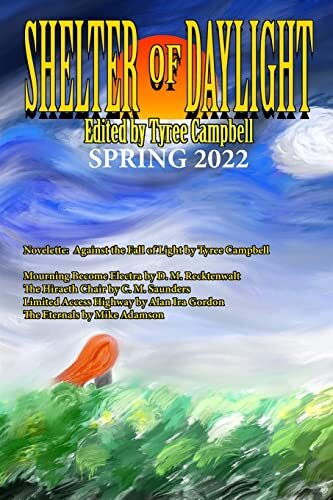
Hiraeth is a Welsh word. There is no direct English translation, but it is basically used to describe a deep longing or sadness, often tinged with nostalgia and homesickness. I think the most accurate description would be along the lines of missing something, or some place, to which you can no longer return. You can find a more in-depth explanation here.
I played with the concept for a long time. I find it fascinating. I think it’s partly symptomatic of the human condition; whatever we have, wherever we are, most of the time we wish we were somewhere else. Running parallel to this is the notion of time travel. What if we found a way to return to those places we yearn for so much? And what would we leave behind?
This isn’t actually a horror story, which makes a change for me. Nobody dies, and there are no decapitations or slayings. It would probably more accurately be described as soft sci-fi. One reader told me it was one of the saddest stories they’ve ever read. To my mind, it’s not sad. It’s optimistic. It’s whatever you want it to be, I guess. If what that reader says is true, though, then I’ve done my job.
It’s a nice little coincidence, or pure irony, that Shelter of Daylight is published by Hiraeth Books.
June 13, 2022
RetView #59 – 10 Cloverfield Lane (2016)
Title: 10 Cloverfield Lane
Year of Release: 2016
Director: Dan Trachtenberg
Length: 87 mins
Starring: John Goodman, Mary Elizabeth Winstead, John Gallacher Jr.
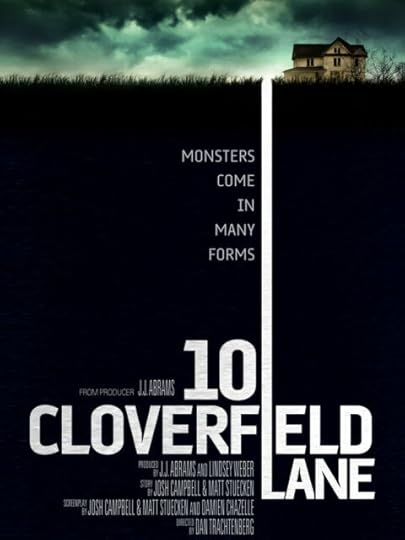
Apart from Quarantine 2 – Terminal I haven’t covered any sequels in this series thus far. There are reasons for that, but it might change in the not too-distant future. For now, you’ll have to make do with this, that rarest of things; a sequel on a par with the original. In fact, 10 Cloverfield Lane isn’t a bona fide sequel at all. In the words of uber-geek producer JJ Abrams, it’s more of a ‘blood relative’ of Cloverfield. The original script was called The Cellar, and had nothing whatsoever to do with the original movie. It was written by Josh Campbell and Matt Steucken back in 2012 before being acquired by Abram’s production company, Bad Robot, and adapted to suit.
When the first Cloverfield movie, a found-footage monster flick, was released in 2008, it became an unexpected smash hit, prompting Abrams to turn it into a loosely-connected franchise which, to date, consists of three films all taking place in the same universe, known as the, ahem, Cloververse, with a fourth in production. Each movie deals with creatures from different dimensions attacking earth as a repercussion of experiments carried out aboard the Cloverfield Station in outer space.
If it’s monsters you’re after, though, you may be disappointed with this particular instalment as it would be more accurately defined as a very effective psychological thriller. It follows twenty-something Michelle (Winstead, who previously starred in Final destination 3 and the 2011 prequel to John Carpenter’s The Thing, also called The Thing, confusingly enough ) who, after splitting up with her boyfriend, is involved in a car accident. She wakes up in an underground bunker with a broken leg and is told by the bunker’s owner Howard (Goodman) that he took her there for her own protection because the air outside has been poisoned as a result of earth coming under some kind of attack. Suspecting Howard deliberately ran her off the road and abducted her, Michelle is immediately suspicious but has little choice but to play along. The mystery thickens when she is introduced to the bunker’s third occupant, Emmett (Gallacher Jr), who tells her he had been employed by Howard to help him build and stock it. He saw an explosion in the sky and, fearing for his safety, forced his way inside, injuring his arm in the process.
Still dubious, Michelle makes up her mind to steal the keys to Howard’s truck and make good her escape. But before she can open the hatch leading to the outside world, she sees a woman outside covered in skin legions and begins to think Howard may be telling the truth. Bunker life isn’t THAT bad. They have plenty of food and water, and enough books, DVD’s and board games to keep them occupied. However, as the unlikely trio settle down to ride out the metaphorical storm, certain troubling details begin to emerge about Howard. What happened to his missing daughter? What kind of ‘waste’ is he disposing of in that vat of acid in the bunker? What made him flip out playing charades? And why does he dislike Emmett so intensely? All this, added to the tension, growing cabin fever, and general air of paranoia, makes for a powerful movie with a nerve-shredding climax. I’m not going to give away the ending here, but suffice to say it’s one of the most unexpected and breathtaking in recent memory.
Perhaps surprisingly, the movie was met with generally favourable reviews, levelling out at an impressive 90% on Rotten Tomatoes. The Guardian said it was “More Hitchcock than Xbox” and Jeannette Catsoulis of the New York Times praised the cast and cinematography, saying, “Sneakily tweaking our fears of terrorism, ‘10 Cloverfield Lane,’ though no more than a kissing cousin to its namesake, is smartly chilling and finally spectacular.” Its critical success was replicated at the Box Office, where it grossed over $110 million from a $15 million budget. Not quite as impressive as the first instalment, but close enough.
GO HERE for more RetView entries.
Trivia Corner
In one scene, Howard is watching the 80’s classic Pretty in Pink. In this movie, Molly Ringwald’s character has a hobby of making dresses. This is a subtle reference to Michelle, who had earlier confided to Howard that she dreams of being a fashion designer.
June 3, 2022
Drabbledark II
I’m pleased to announce that my story The Hungry is included in Drabbledark II: An Anthology of Dark Drabbles, out now on Shacklebound Books. The anthology, edited by Eric Fomley, promises, “A ton of amazing dark horror, science fiction and fantasy drabbles.”
The Hungry was inspired by Dan Simmons’s The Terror, itself a fictionalized account of Sir John Franklin’s lost expedition to the arctic. I’ve always thought they should’ve known better than to get on a ship called HMS Terror. They may as well have called it HMS You’re Fucked.
Check out the amazing cover art:

Go here for the full ToC.
Drabbledark II is out now on ebook and paperback.
May 20, 2022
Trigger Warning – Speaking Ill
I’m pleased to announce that my short story Eeva is included in the new anthology Trigger Warning – Speaking Ill, edited by John Baltisberger and released on Madness Heart press.
From the blurb: “Through strange, terrifying, and disgusting horror, these 9 authors ensure that death is no safe space. No corpse will escape their due through death, but will instead be allotted the full measure of what our authors have in store.”
This is your trigger warning.
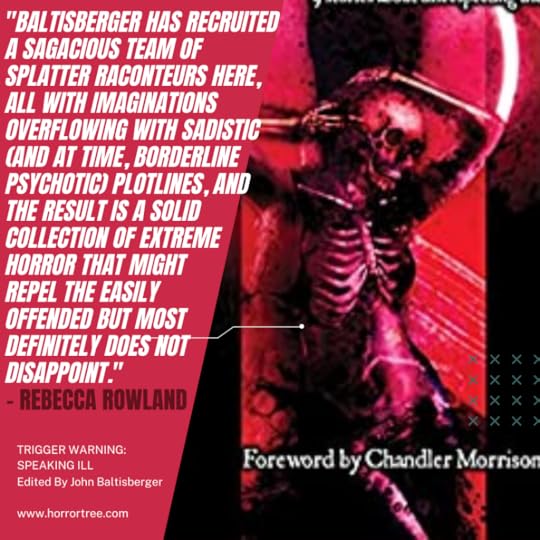
Eeva is ostensibly a story about getting a Facebook friend request from some murky figure in your past and all the memories that it might dredge up. That’s probably something we’ve all experienced. On a more personal level, its about a Finnish exchange student I met (who wasn’t called Eeva) at university who may or may not have been a vampire. Vampire or not, the bit about her inviting three blokes on a weird group date simultaneously really did happen. By the end it turned into a ‘last man standing’ scenario. Maybe they do things differently in Finland.
Writing for Horror Tree, Rebecca Rowland said, “For those readers trapped in the monotony of working “stuffed in a corporate box,” C.M. Saunders’ “Eeva” revisits the youthful excitement and nostalgic novelty of strange desires. The narrator receives a friend request from a woman he knew briefly in college. Most of his social media inquiries are from “obviously-fake catfish accounts made in the image of busty Russian beauties called Layla, or Filipino women who tell me they love me then ask me to buy them a new phone,” but this notification piques his interest, and that’s because Eeva isn’t a textbook case of lost love. Hidden beneath her bohemic façade was a primal nature that went deeper than the narrator ever could have imagined. To reveal any more would be to spoil the climax, but be warned: readers should go forth with a strong stomach.”
You can read the rest of her review here.
Trigger Warning – Speaking Ill is out now.
May 13, 2022
RetView #58 – Doomwatch (1972)
Title: Doomwatch
Year of Release: 1972
Director: Peter Sasdy
Length: 92 mins
Starring: Ian Bannen, Judy Geeson, John Paul, Simon Oates, Jean Trend
Given what we’ve done to our world, you could argue that we’re already living in an age of ecological terror. Movies like Doomwatch may exaggerate certain elements for dramatic effect, but in essence they serve to ram home the point. This is what happens when man interferes with the delicate balance of nature. The movie was based on the BBC TV series of the same name which ran from 1970-72 and focused on a government department charged with combatting technological and environmental dangers, making it a kind of eco-friendly X Files. Ironically, as was standard practice back in the day, after airing the master tapes were wiped by the BBC and recorded over as a cost-cutting measure, meaning that many of the episodes have been lost forever. Luckily, we still have the movie spin-off produced by Tigon British Film Productions, who had previously made Witchfinder General (1968) which was released in March 1972. In the the United States, it was released by Embassy Pictures with the alternative title Island of the Ghouls.
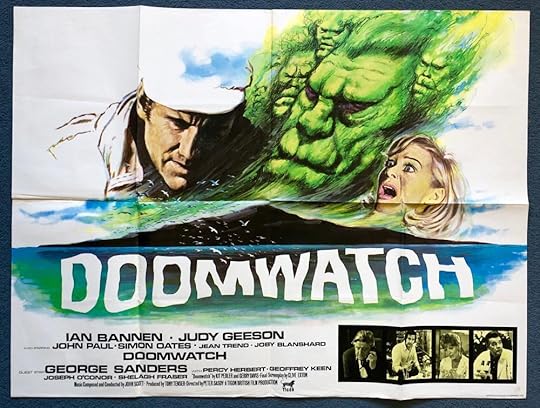
So… what’s this all about? Well, we have Doctor Del Shaw (Bannen), an investigator from the British ecological watchdog group nicknamed Doomwatch, who is dispatched to an insular fishing village on the island of Balfe off the Cornish coast to file a report on the effects of a recent oil tanker spill. There, he finds a child’s body hidden in the woods and becomes fascinated with the mysterious behavioural disorders of the locals who display rudeness and random aggression and generally act like a bunch of arses as they rebuff his attempts to solve the mystery. One woman loses her shit when Shaw tries to take her picture, yelling, “We don’t like that! Taking people’s likeness! We don’t like that kind of carry on at all, in fact!”
Shaw teams up with another outsider, a schoolteacher called Victoria (Gleeson), and notes certain physical abnormalities, such as a strange genetic prevalence of thick lips and sloping brows, in many of the local populace. His investigation reveals that the villagers have been suffering over a prolonged period from hormonal disorders, which are likely being caused by leeking drums of growth stimulants that have been dumped offshore by callous business types. The islanders have been infected by eating fish and as a result are developing acromegaly, (usually the result of interbreeding, wink-wink) which produces aggression and eventually madness.
Though the movie was well-received by the public, writing for Radio Times, Tom Hutchinson only awarded the film two stars out of five, stating, “This mystery thriller crash-landed unhappily in the swamp of horror instead of on the firmer ground of science fact or fiction. It’s risibly alarmist, certainly, but the environmental dangers it pinpoints are only too topical.”
True, the movie comes with a great premise and both starts and finishes well, but it sags slightly in the middle and is weighed down with far too much long-winded, redundant dialogue which seems to exist purely for clever people to show everyone just how clever they are. Sometimes, less is more. There is also some confusion as to how the locals are portrayed. You get the feeling director Peter Sasdy would like you to sympathise with them, which is hard, because frankly, most of them have been dicks throughout and have very few redeeming qualities. I like to think that this conflict is intentional, though it that doesn’t make it any less jarring. A contemporary review for cultmovieforums.com notes, “It has to be said that while Doomwatch ultimately remains something of a missed opportunity by any standard of judgment, Peter Sasdy’s film is still in all fairness, probably a slightly better film than what its poor reputation might suggest.”
Generally, the all-too believable storyline of corporate greed combined with the overriding sense of isolation make good use of Sasdy’s talents, a man who made his name directing Blood of Dracula (1969) and Hands of the Ripper (1971) for Hammer before turning his attention to the TV production of Sue Townsend’s classic The Secret Diary of Adrian Mole Aged 133/4. Curiously, references to a certain Castle Rock will no doubt strike a chord with some of Stephen King’s constant readers and could offer clues as to where the Master acquired the name. In 1999, Channel 5 in the UK bought the rights to Doomwatch from the BBC and in December that year screened a 100-minute TV movie, which was a continuation of the story rather than a remake. Though the movie was well-received it didn’t lead to the anticipated series, perhaps due to the amount of money it would require. Still, it’s a great concept, and could be a huge success in the right hands.
Trivia Corner:
Both the film and the original series was created by Gerry Davis and Kit Pedler, who had previously collaborated on scripts for Doctor Who. Their interest in the problems of science changing and endangering human life apparently led them to create the popular cyborg villains the Cybermen.
April 24, 2022
The War on Verbosity
Definition:
Verbosity (noun): “The fact or quality of using more words than needed; wordiness.”
I know. For years you’ve been hearing about wars against drugs, obesity, terrorism, racism and baldness. The last thing you want is another one. But trust me, when considering the future of the written word, verbosity is just as much of a problem as any of those Real World issues, especially among young, inexperienced writers.
We all know those people who talk incessantly, dancing around whatever it is they want to say but lacking the confidence or courage to do so directly. Instead, they hope you connect the dots and do the dirty work for them.
It’s annoying, right?
Likewise, there are the people who hit the point right on the head with deadly accuracy. But then they just keep on hitting, saying the same thing over and over again, maybe using different words in an effort to give the impression that they’ve moved when in reality they are rooted to the spot.
Both these kinds of people waste our time, agreed?
In the literary world, verbosity has a similar effect. Consider this sentence:
“The skies opened, unleashing a slick torrent of rain which lashed against the dirty, lightly condensed window glass sounding like untold numbers of heathens banging their fists against the cold, unrelenting gates of heaven.”
Now consider this alternative:
“It was raining heavily.”
Or maybe:
“The rain lashed down.”
Granted, neither option is as evocative or spectacular as the first passage. But in effect they say the same thing, and move the story along to the same point in a fraction of the time. By comparison, the first sentence is dense and unfocused. You have to wade through a lot of padding to get the point.
You are probably wondering why verbosity bothers me so much.
Allow me to explain.
A lot of people send me samples of their work to read or critique, something I am usually more than happy to do. If you do this enough, certain patterns or traits begin to emerge. I can spot a novice writer because most of them take forty or fifty words to say something a more experienced writer would say in six or eight. It was raining. Got it. What more do you need to know? Anything else is just superfluous. Set the tone by all means, but know when you are entering ‘overkill’ territory. In the early stages of your writing career it is simply a matter of honing your craft.
Of course, there are times when a touch of verbosity is justified. Or even required. Especially at points in the story you want the reader to remember for maximum impact. Maybe a touching love scene, or the death of a leading character. But trust me, nobody wants to wade through three or four paragraphs of flowery prose describing in technicolour detail how much it’s raining outside and how wet the water is. What’s the point? You might think it’s the best thing ever written in the history of mankind, but it probably isn’t. Trust me, unless you keep things moving apace the reader will get bored very quickly. With so much choice out there, once you lose a reader, it’s very difficult to win them back.
Any good editor will tell you that you shouldn’t use more words than absolutely necessary. There was a time when you could have gotten away with it, but this isn’t the 19th Century anymore. Treat words as precious commodities, not something you have a surplus of. Give your readers some respect, and acknowledge they are busy people. Get to the point with the minimum of fuss, and pretty soon you’ll begin to see marked improvements in your writing.
This post first appeared on the now-defunct Deviant Dolls website.
See here for my thoughts on the dreaded writer’s block.
April 13, 2022
RetView #57 – What a Carve Up! (1961)
Title: What a Carve Up!
Year of Release: 1961
Director: Pat Jackson
Length: 87 mins
Starring: Sid James, Kenneth Connor, Shirley Eaton, Dennis Price, Donald Pleasence, Michael Gough
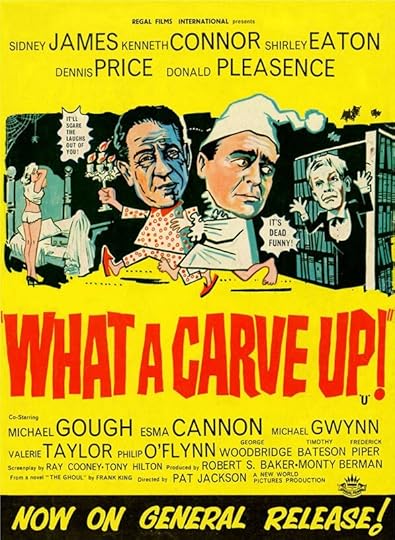
Okay, this isn’t strictly a horror film. It’s more of a comedy in the Carry On Screaming vein. By coincidence, it even features some of the ‘Carry On’ lot. Though leaning more toward comedy, it was effectively marketed as a comedy horror, and is therefore worthy of a place on this list, the purpose of which is not only to celebrate the classics, but also the derided, forgotten and overlooked. If anything, I lean more toward the derided, forgotten and overlooked in an effort to make them slightly less so. What A Carve Up! is intentionally full of old-school horror tropes and cliches, from misty moors and old haunted mansion to secret passages and clandestine murders, and is all done with that distinctively quaint English charm. The film was loosely based on the novel The Ghoul by Frank King, which had been adapted for the screen in 1933.
When affable yet unremarkable Ernie Broughton (Connor), who spends far too much time with his head buried in horror novels, recieves word that a distant uncle of his has died, he travels to a secluded country mansion for a reading of the will with flatmate Syd Butler (James). There, the duo meet an eccentric selection of distant relatives, a butler (Michael Gough in the same kind of role that later defined him in the Batman films), and a mad piano player. Soon after they arrive, one of their number is found murdered, forcing the others to spend the night in the company of the killer, who doesn’t stop at one. The night quickly descends into a riotously funny battle for survival, and a hunt to unmask the crazed killer. One of the funniest moments comes when someone calls the police and an Inspector accuses Ernie of not being as much of a fool as he makes out. “But I am!” he protests. All this leads to a predictably preposterous ending and final unveiling, but by then you won’t even care who the killer is because arriving at that point is such good fun.
The title itself works as a pun on carving up (dividing) the deceased family estate, and ‘carve up’ as in cutting meat, a reference to knife murder, one of the ways one of the victims are dispatched. In America, the title was changed to, “No place like a homicide!” which is obviously a play on the phrase “No place like home” which also works as its set in an ancestral family home. The phrase had been buried in the American psyche since popularized by the character Dorothy Gale in The Wizard of Oz (1939). I do love a good pun. Perhaps surprisingly, the movie didn’t fare so well in America, and wasn’t helped by a spate of indifferent reviews, like the one to be found in the New York Times on 13th September 1962, which stated, “The fact that a film of this degree of vulgarity and ineptitude should have managed a week’s booking at neighbourhood theatres throughout Manhattan demonstrates just how acute the motion picture product shortage really is.”
Even so, over the years What a Carve Up! has deservedly won cult status in the genre labelled ‘dark house’ by some. In truth, it’s a parody, and a very effective one, which is hardly surprising given that it was co-written by the king of the double entendre, Ray Cooney. Incidentally, the director Pat Jackson went on to lend his skills to The Prisoner and the Professionals, among other things, and it was a huge influence on the 1994 novel of the same name by Jonathan Coe which won the John Llewellyn Rhys prize, one of the oldest literary awards in the UK. Its current overall score on Rotten Tomatoes stands at a respectable 66% while it has been ‘liked’ by 91% of Google users. It’s also notable for a late, uncredited cameo from teen idol Adam Faith. You can watch What a Carve Up on YouTube.
Trivia Corner:
The butler Fisk is pictured reading a copy of DH Lawrence’s “Lady Chatterley’s Lover.” In 1961, this was a subtle, yet timely gag as its publishers Penguin Books had been prosecuted under the Obscene Publications Act in a widely-publicized trial at the Old Bailey the previous year.
April 2, 2022
Heartless Cat’s Eyes
Cat’s Eyes, my disturbing little drabble about dating dangerously, is included in Heartless, part of the ‘Holiday Horrors’ series of anthologies published by Black Ink Fiction.
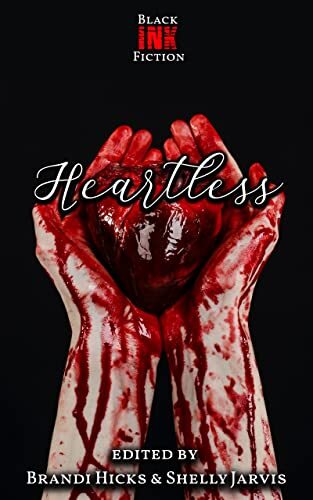
From the cover:
What happens when love goes horribly, gruesomely wrong? A red wedding, a sacrifice to Saint Valentine, blind dates gone amiss…there are so many ways romance can be twisted. This anthology, with over 40 international authors, is not for the faint of heart.
Heartless is out now on ebook and paperback
March 20, 2022
Don’t Fall Asleep podcast
I’m bloody excited to have one of my stories, The Others, featured on the near-legendary Don’t Fall Asleep podcast put together by those amazingly gory folk at Bloodbound Books!
The Others is about a Tinder date going wrong. Very wrong. You can read more about the furry-themed story and where it came from HERE.
Listen in to Don’t Fall Asleep on Spotify, or wherever you get your podcasts, for a chance to win a paperback Burnt Fur, the anthology the Others was originally published in. You can also find it on YouTube.
Don’t forget to check out the Bloodbound Books website for a ton of free content including my splattery short Siki’s Story.
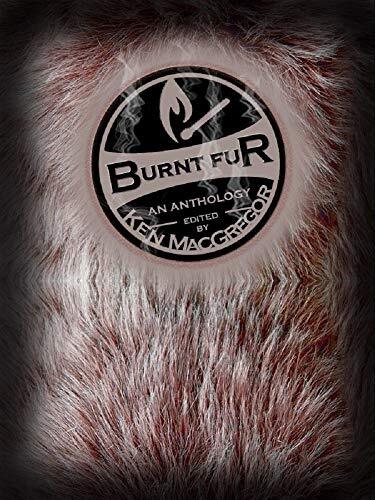
March 13, 2022
RetView #56 – Fright Night (1985)
Title: Fright Night
Year of Release: 1985
Director: Tom Holland
Length: 106 mins
Starring: Chris Sarandon, William Ragsdale, Amanda Bearse, Roddy McDowall, Stephen Geoffreys
Something occurred to me recently. So far, I haven’t covered many vampire movies in the RetView series. In fact, the only ones I’ve featured have been Lost Boys and Kolchak: The Night Stalker. Personally, I just find the whole vampire thing a bit naff and predictable. If you’ll excuse the pun, it’s been done to death. Hurrah! That’s why, to my mind, the vampire legend is best done with a splash of humour, like both the aforementioned did with great success. Another vampire comedy horror classic is Fright Night from 1985, the year of Brothers in Arms, Live Aid and Miami Vice. It became the second highest grossing horror movie of the year behind A Nightmare on Elm Street Part 2: Freddy’s Revenge, and is notable for being the directorial debut of Tim Holland, who went on to direct Child’s Play (1988) and Thinner (1996) as well as episodes of Amazing Stories and Tales from the Crypt. The movie also benefited from a Big Eighties Soundtrack featuring the likes of the J Geils Band, who performed the title track, Autograph, April Wine and Ian Hunter, the irony being that most of these artists were already streaking into irrelevance having peaked long before. Much like the vampire itself. If the producers had been a bit more adventurous and signed someone a bit more contemporary (like the Elm Street franchise did a couple of years later when they hired Dokken to record the seminal Dream Warriors, or when the makers of Shocker persuaded Megadeth to get involved) it could’ve made all the difference. Still, Fright Night didn’t really need the Big Eighties Soundtrack, it was a massive hit anyway, winning three Saturn awards and grossing over $24 million, despite Columbia having very low expectations of it.

17-year-old Charley Brewster (Ragsdale) is a fan of horror films and a late-night TV series entitled Fright Night hosted by former ‘vampire hunter’ Peter Vincent (McDowall). One evening, Charley discovers that his new next door neighbour, Jerry Dandrige (Sarandon) is the blood-thirsty sucker responsible for several mysterious disappearances. In desperation, he alerts the authorities but, unable to find any evidence, they brush off Brewster’s claims and leave him at the mercy of an angry and vengeful Dandridge. Fearful for the safety of himself and his girlfriend Amy (Bearse) and with no other choice, Brewster goes to best friend Evil Ed (Geoffreys) and his idol, Vincent, for help. Together the motley crew battle the forces of evil. Or try to. But far from being a fearless vampire hunter, Vincent turns out to be a bit of a scaredy cat, as well as a fraud, Brewster’s best friend is a bit of a dick, and his girlfriend appears to have the horn for his nemesis.
The writing in Fright Night is top-notch, as are some of the performances. Stephen Geoffreys (who, ironically, went on to star in 976-EVIL a couple of years later) is brilliant as Evil Ed, but it’s Roddy McDowall who steals the show. One of those saturn awards went to him for ‘Best Supporting Actor.’ His character was named after horror icons Peter Cushing and Vincent price, for whom Holland had specifically written the part. However, at this point in his career, Price had been so badly typecast that he had stopped accepting roles in horror movies. Hollywood badboy Charlie sheen auditioned for the part of Brewster, and I can’t help feeling he would have been amazing as the bumbling teen, but Holland thought Sheen was a ‘hero’ while Ragsdale was, quite literally, “the guy next door.” For her final transformation as a busty vampire, Amanda Bearse wore a prosthetic breast plate to enhance her cleavage. Legend has it that in 2012 she took it to a horror convention and encouraged fans to ‘feel her boobs’ while she signed autographs. Brilliant.
Fright Night as a franchise has grown to include a sequel, imaginatively entitled Fright Night Part 2 (1988) and a remake in 2011. When later asked his thoughts about it, Tom Holland said, “Kudos to them on every level for their professionalism, but they forgot the humor and the heart. They should have called it something other than Fright Night, because it had no more than a passing resemblance to the original.”
Ouch.
The remake was itself followed by a sequel Fright Night 2: New Blood (2013), as well as numerous comics, graphic novels and a video game. Interestingly, the movie even made the crossover to Bollywood in 1989 with a version called Kalpana House (1989), and was adapted for the stage in 2018. Proof positive that, just like the vampires of myth and legend, Fright Night lives on. And on.
Trivia Corner
The makeup for Evil Ed’s wolf transformation took 18 hours to complete. While he had the wolf head on, the crew began pouring what they thought was Methylcellulose into his mouth to create the illusion of saliva, but when Geoffreys began to complain about the taste, the crew realized they’d been using prosthetic adhesive, which was gluing his mouth shut. Doh.



